

高等学校化学学报 ›› 2021, Vol. 42 ›› Issue (2): 556.doi: 10.7503/cjcu20200565
收稿日期:2020-08-16
出版日期:2021-02-10
发布日期:2020-11-19
通讯作者:
张如范
E-mail:zhangrufan@tsinghua.edu.cn
基金资助:
JIANG Qinyuan, ZHOU Chenhui, MENG Haibing, HAN Ying, ZHANG Rufan( )
)
Received:2020-08-16
Online:2021-02-10
Published:2020-11-19
Contact:
ZHANG Rufan
E-mail:zhangrufan@tsinghua.edu.cn
Supported by:摘要:
二维金属有机框架材料(MOFs)由于具备高比表面积、 多孔性以及丰富的活性位点等优异特性而受到广泛关注, 并且在电催化领域展现出巨大的应用潜力. 研究者们已在二维MOFs的可控制备与电催化性能调控方面取得许多突破性进展, 显示出相关研究对开发高性能电催化剂的关键作用. 本文总结了二维MOFs的自上而下和自下而上合成策略以及二维MOFs衍生物的典型合成方法, 概述了二维MOFs在各尺度下的电催化性能调控策略, 并介绍了各种合成方法和调控策略在电催化中的应用. 最后讨论了该领域面临的挑战, 并对未来的发展方向进行了展望.
中图分类号:
TrendMD:
姜沁源, 周晨晖, 蒙海兵, 韩莹, 张如范. 二维金属有机框架材料的合成及电催化应用. 高等学校化学学报, 2021, 42(2): 556.
JIANG Qinyuan, ZHOU Chenhui, MENG Haibing, HAN Ying, ZHANG Rufan. Synthesis and Electrocatalytic Application of Two-dimensional Metal-organic Frameworks. Chem. J. Chinese Universities, 2021, 42(2): 556.
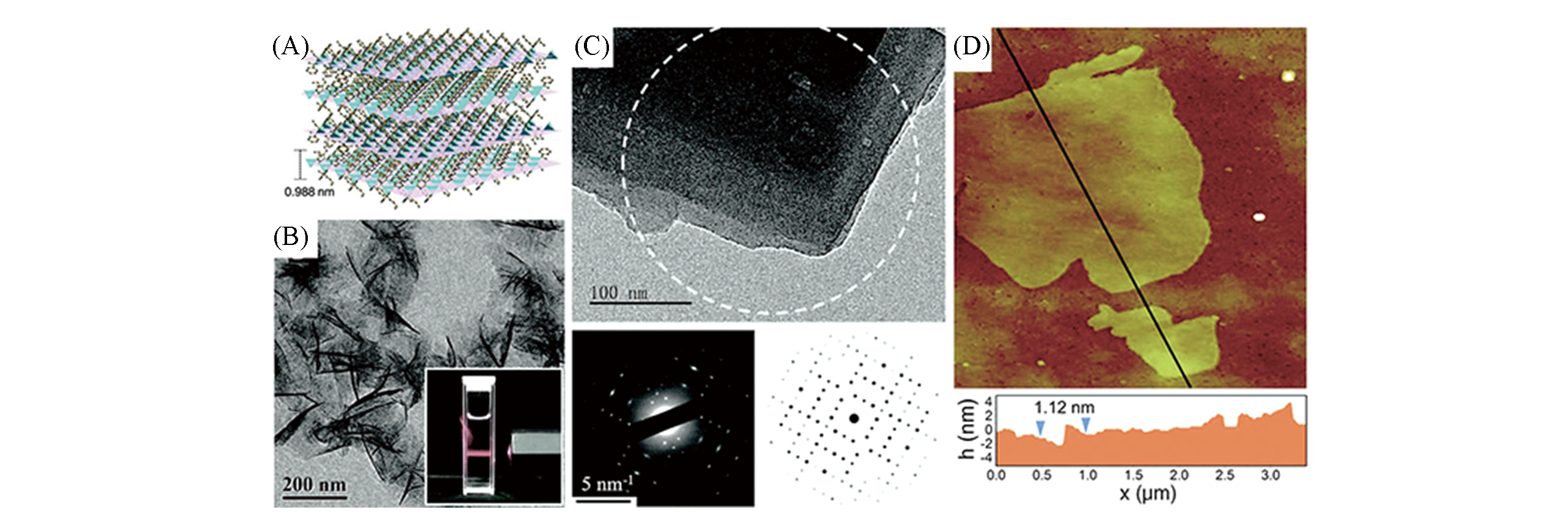
Fig.1 Sonication exfoliation of MOFs with layered structure[45](A) Schematic illustration of the layered structure of Zn2(bim)4;(B,C) TEM images and the corresponding SAED patterns of Zn2(bim)4 nanosheets;(D) AFM image and the corresponding height profile of Zn2(bim)4 nanosheets. Copyright 2014, American Association for the Advancement of Science.
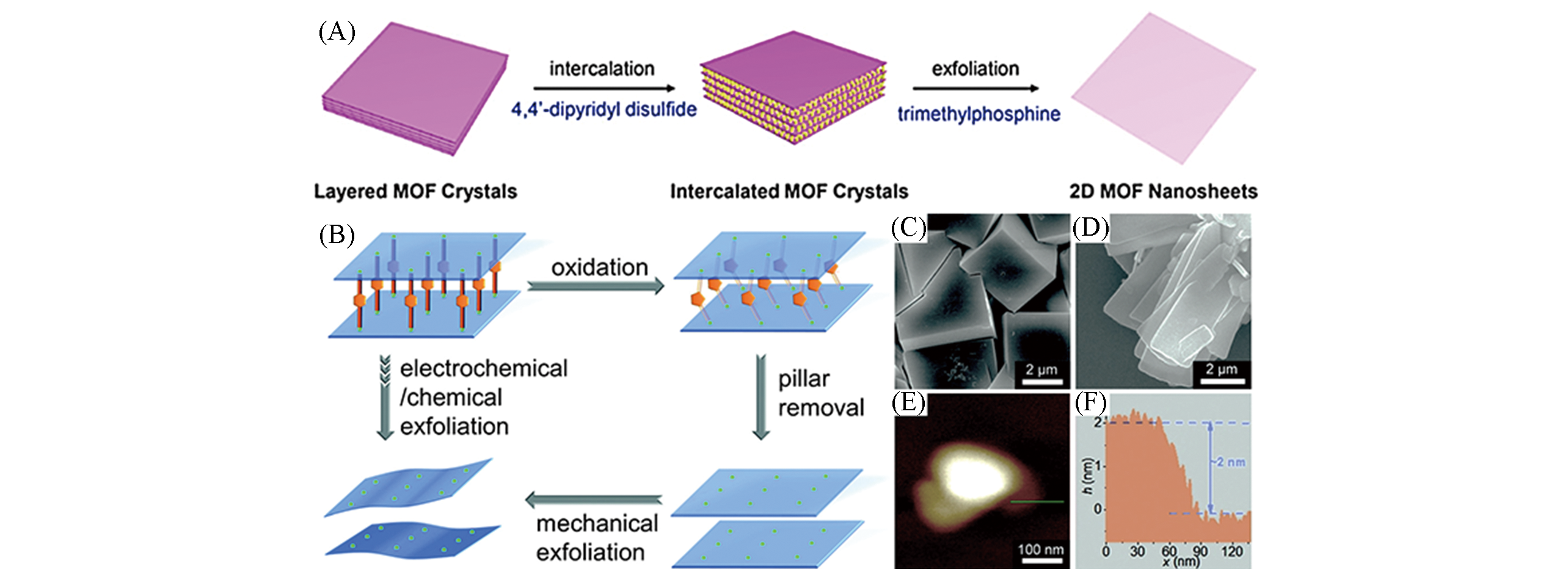
Fig.2 Intercalation synthesis of 2D MOF nanosheets(A) Schematic illustration of the intercalation synthesis of 2D PPF-1 nanosheets[39]; Copyright 2017, American Chemical Society; (B) schematic illustration of the exfoliation of a pillared-layer MOF; SEM images of bulk(C) and exfoliated(D) MOFs; AFM image(E) and the corresponding height profile(F) of exfoliated MOF nanosheets[50]. Copyright 2018, Wiley-VCH.

Fig.3 Micromechanical exfoliation of 2D MOF nanosheets[53](A) Structural model of MAMS-1;(B) schematic illustration of the freeze-thaw exfoliation process. Copyright 2017, Springer Nature.

Fig.4 Direct solvothermal synthesis of 2D MOF nanosheets[61](A) Schematic illustration of the synthetic process of Ni-Fe-MOF;(B, C) TEM images of Ni-Fe-MOF;(D) AFM image and measured thicknesses of Ni-Fe-MOF. Copyright 2019, Wiley-VCH.

Fig.5 Surfactant? and modulator?assisted synthesis of 2D MOF nanosheets(A) Comparison between traditional synthesis and surfactant-assisted synthesis of PPF nanosheets; (B) TEM image and (C) SAED pattern of PPF nanosheets[31]. Copyright 2015, Wiley-VCH; (D) structure of the M6 cores and BTB ligands in Hf6(μ3-O)4· (μ3-OH)4(HCO2)6(BTB)2; (E) formation of 2D lattice from 6-connected cores and 3-connected ligands;(F) TEM image of Hf6· (μ3-O)4(μ3-OH)4(HCO2)6(BTB)2 nanosheets; (G) structural representation of the ruffled sheet[71]. Copyright 2016, Wiley-VCH.

Fig.7 Sonochemical synthesis of 2D MOF nanosheets[83](A) Structural illustration; (B, C) TEM(B) and AFM(C) images of NiCo-UMOFNs. Copyright 2016, Springer Nature.
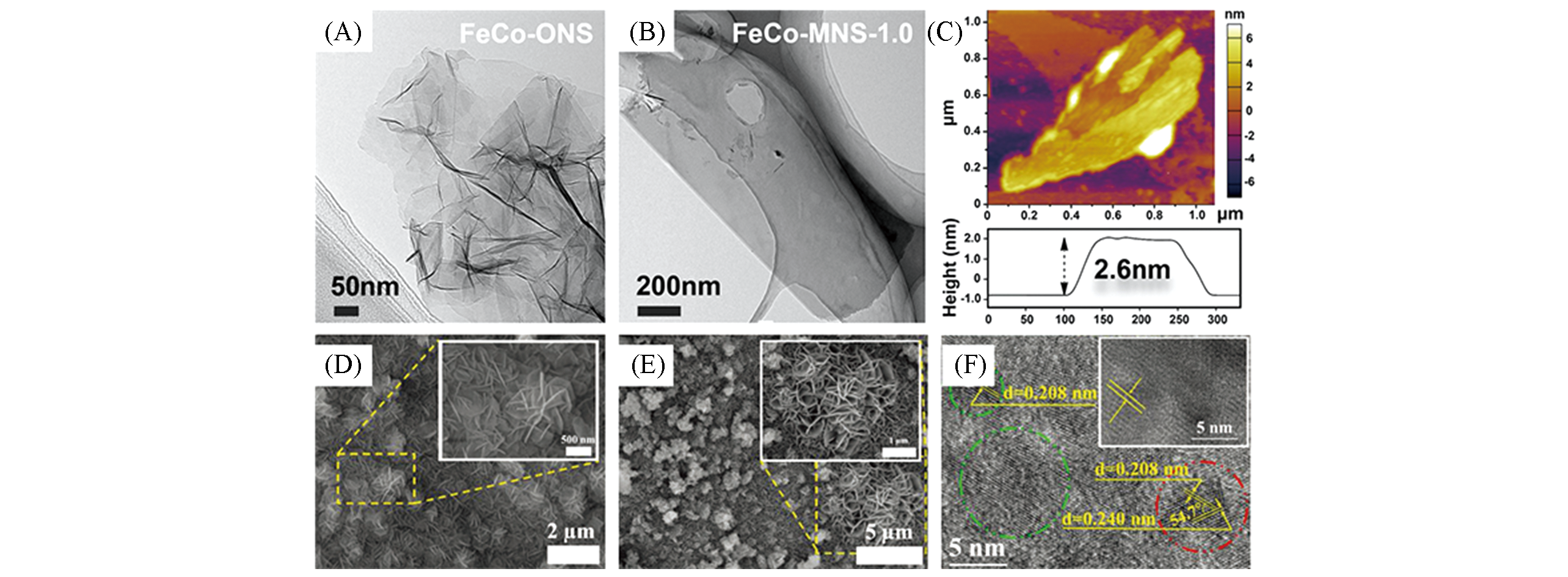
Fig.8 Template?assisted synthesis of 2D MOF nanosheetsTEM images of ONS(A) and ONS-derived(B) MOF-74 nanosheets;(C) AFM image of ONS-derived MOF-74 nanosheets[88]. Copyright 2019, Wiley-VCH. SEM images of LDH arrays(D) and LDH-derived(E) 2D MOF nanosheets;(F) HRTEM image of LDH-derived 2D MOF nanosheets[87]. Copyright 2019, Wiley-VCH.

Fig.9 Pyrolysis carbonization for synthesizing carbon nanosheets and metal/carbon nanosheets(A) Schematic illustration of the synthetic route of ZCN; TEM(B) and HRTEM(C) images of ZCN[92]; Copyright 2016, Wiley-VCH; (D) schematic illustration of the synthetic route of Cox-N/C-800; TEM(E) and HRTEM(F) images of Cox-N/C-800[99]; Copyright 2019, Royal Society of Chemistry.

Fig.10 Air calcination for synthesizing metal oxide nanosheets(A) Schematic illustration of the synthetic process of CC@Co3O4; SEM(B), TEM(C) and HRTEM(D) images of CC@Co3O4[102]; Copyright 2017, Royal Society of Chemistry;(E) schematic illustration of the synthetic process of M-Co3O4; SEM images of ZIF-67 nanosheets(F) and M-Co3O4 nanosheets(G); TEM images of ZIF-67 nanosheets(H) and M-Co3O4 nanosheets(I)[100]; Copyright 2018, American Chemical Society.
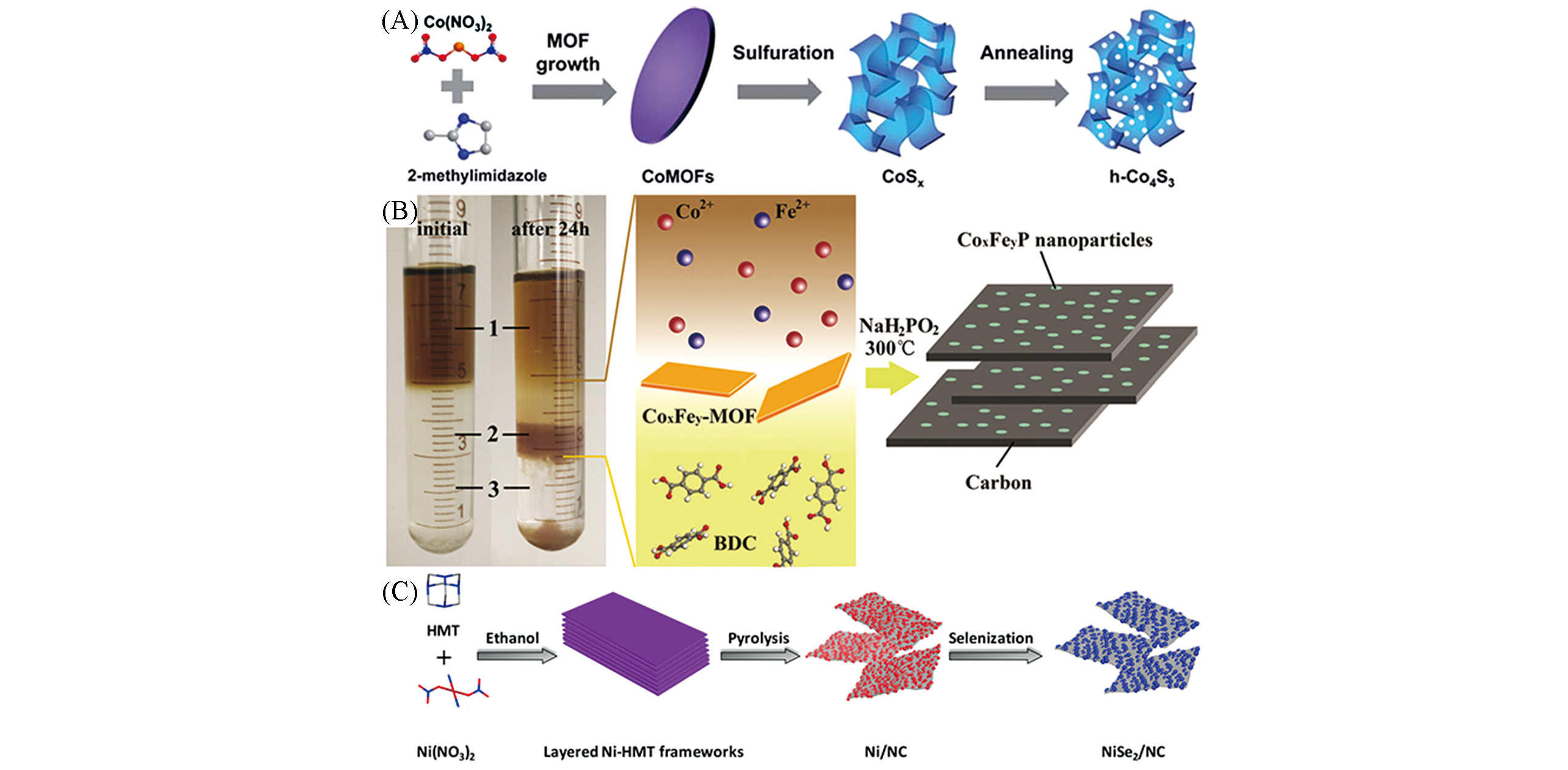
Fig.11 Sulfuration, phosphorization and selenization of 2D MOF nanosheets(A) Schematic illustration of the synthetic process of h-Co4S3[104]; Copyright 2018, Royal Society of Chemistry;(B) schematic illustration of the synthetic process of Co0.7Fe0.3P/C[93]; Copyright 2018, Royal Society of Chemistry; (C) schematic illustration of the synthetic process of NiSe2/NC[105]; Copyright 2018, American Chemical Society.

Fig.12 Construction of hierarchical pore structures in MOFs(A) Schematic illustration of the formation process of (Ni2Co1)1-xFex-MOF-NF; SEM(B) and TEM(C, D) images of (Ni2Co1)0.925Fe0.075-MOF-NF[113]; Copyright 2019, Wiley-VCH;(E) schematic illustration of the formation process of U-MOF and (U+S)-MOF; SEM(F), TEM(G) and HRTEM(H) images of(U+S)-MOF[114]; Copyright 2019, American Chemical Society.
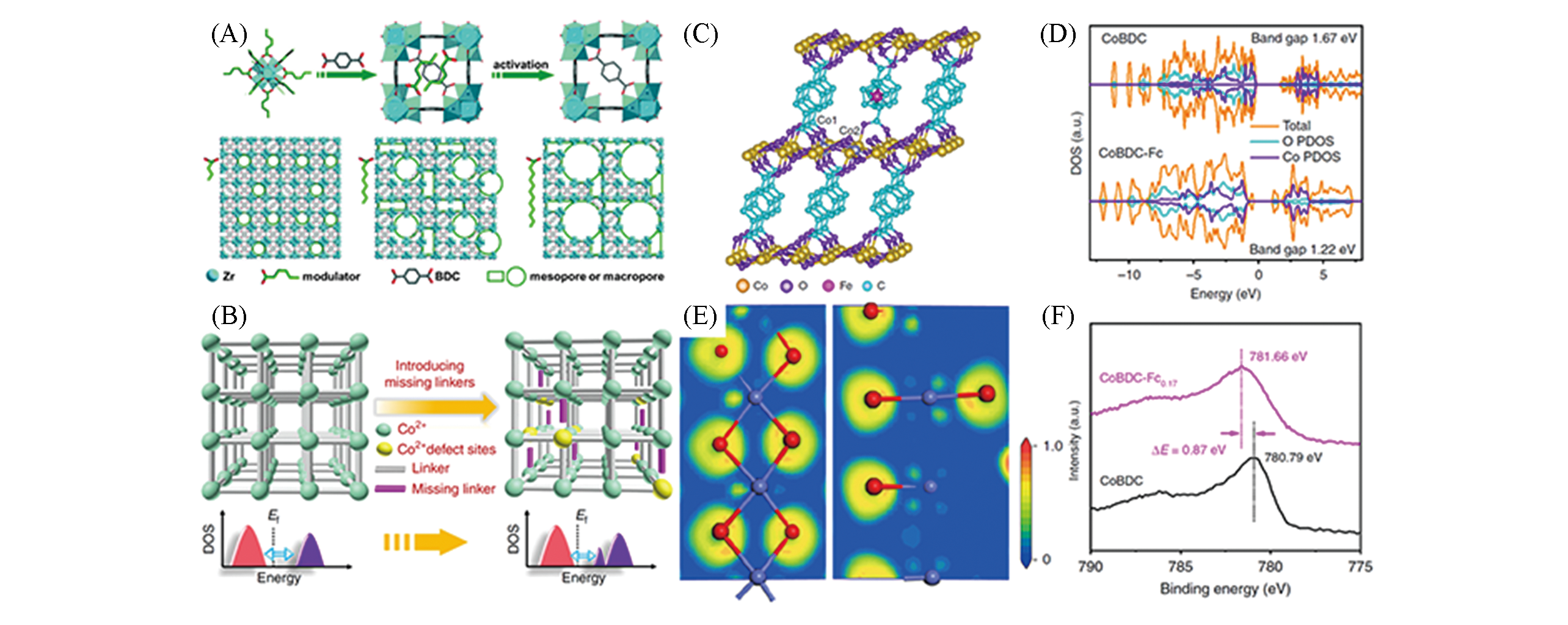
Fig.13 Defect modulation of MOFs(A) Schematic illustration of the synthesis of MOFs with defects and hierarchical pore structure[17]; Copyright 2017, Wiley-VCH; (B) schematic illustration of the modulation of electronic structure by introducing missing linkers; (C) crystal structure of CoBDC-Fc; (D) calculated DOS of CoBDC and CoBDC-Fc; (E) ELF of CoBDC-Fc; (F) Co2p3/2 XPS spectra of CoBDC-Fc[117]; Copyright 2019, Springer Nature.
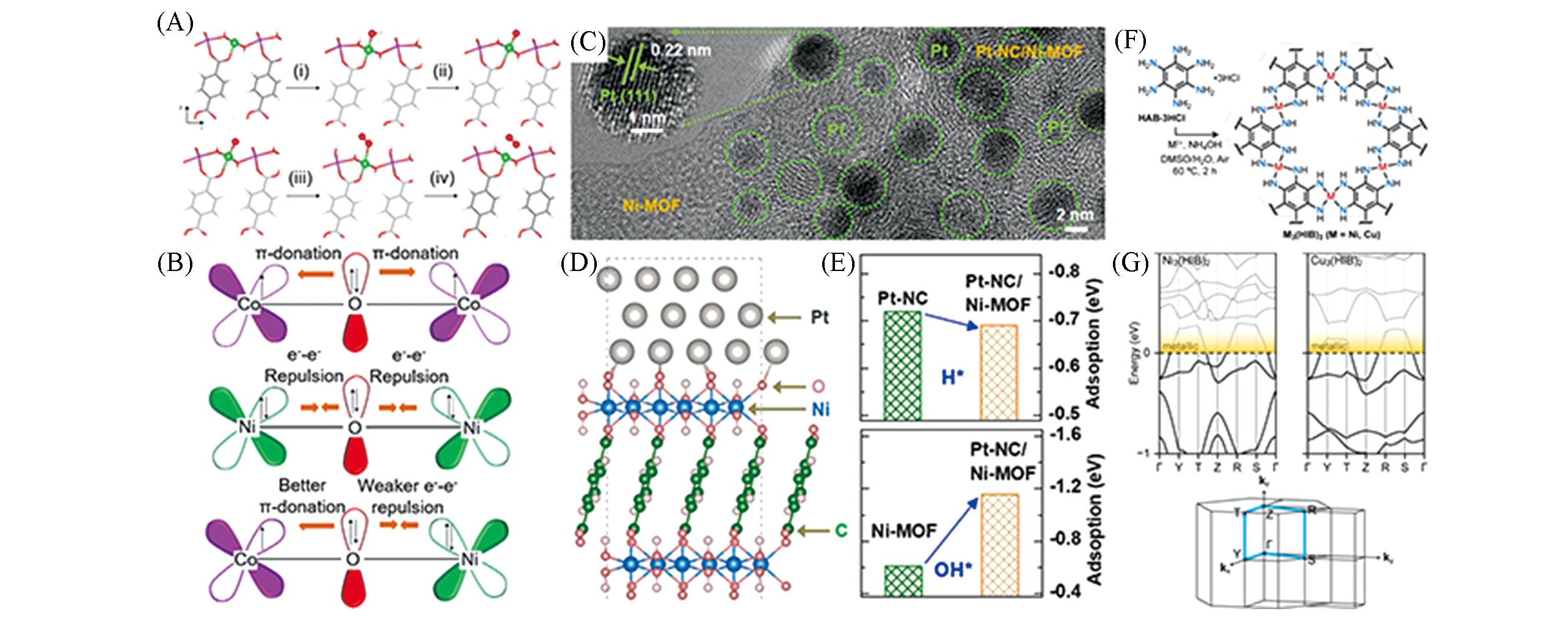
Fig.14 Electron modulation of MOFs(A) Primitive steps of the oxygen evolution reaction process on MOFs;(B) schematic representation of the electronic coupling between Co and Ni[83]; Copyright 2016, Springer Nature; (C) TEM image of Pt-NC/Ni-MOF; (D) structural model of Pt-NC/Ni-MOF; (E) H* adsorption and OH* adsorption energy comparison[121]; Copyright 2019, Elsevier; (F) structure and synthesis of M3(HIB)2(M=Ni, Co); (G) band structures of Ni3(HIB)2 and Cu3(HIB)2 and the corresponding first Brillouin zone[119]; Copyright 2017, American Chemical Society.
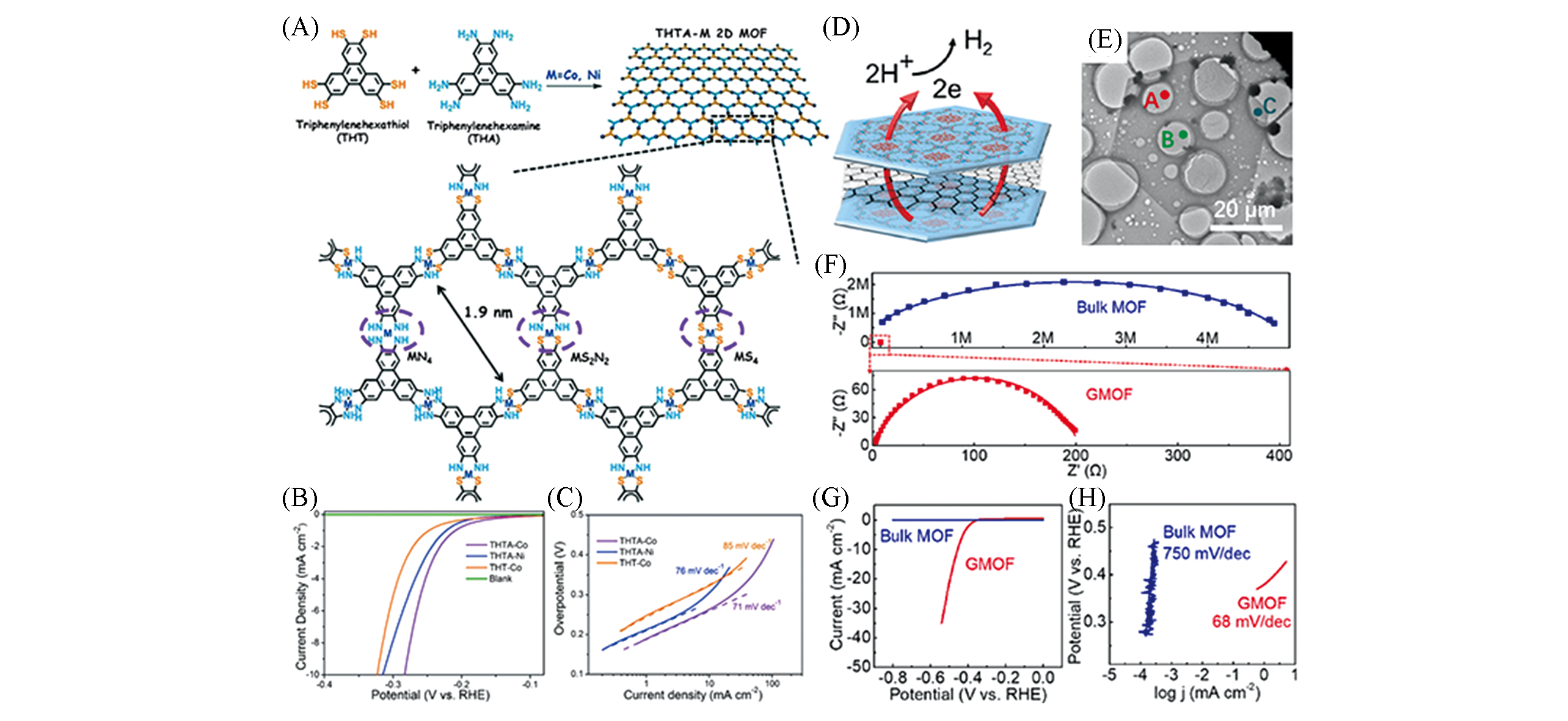
Fig.15 Applications of 2D MOFs in HER electrocatalysis(A) Schematic illustration of the synthesis of single-layer 2D MOFs; HER polarization curves(B) and Tafel plots(C) of single-layer 2D MOFs[78]; Copyright 2015, Wiley-VCH; (D) structural illustration of GMOF; (E) TEM image of GMOF; (F) comparison of the Nyquist plots of GMOF and bulk MOF; HER polarization curves(G) and Tafel plots(H) of GMOF and bulk MOF[128]; Copyright 2019, American Chemical Society.
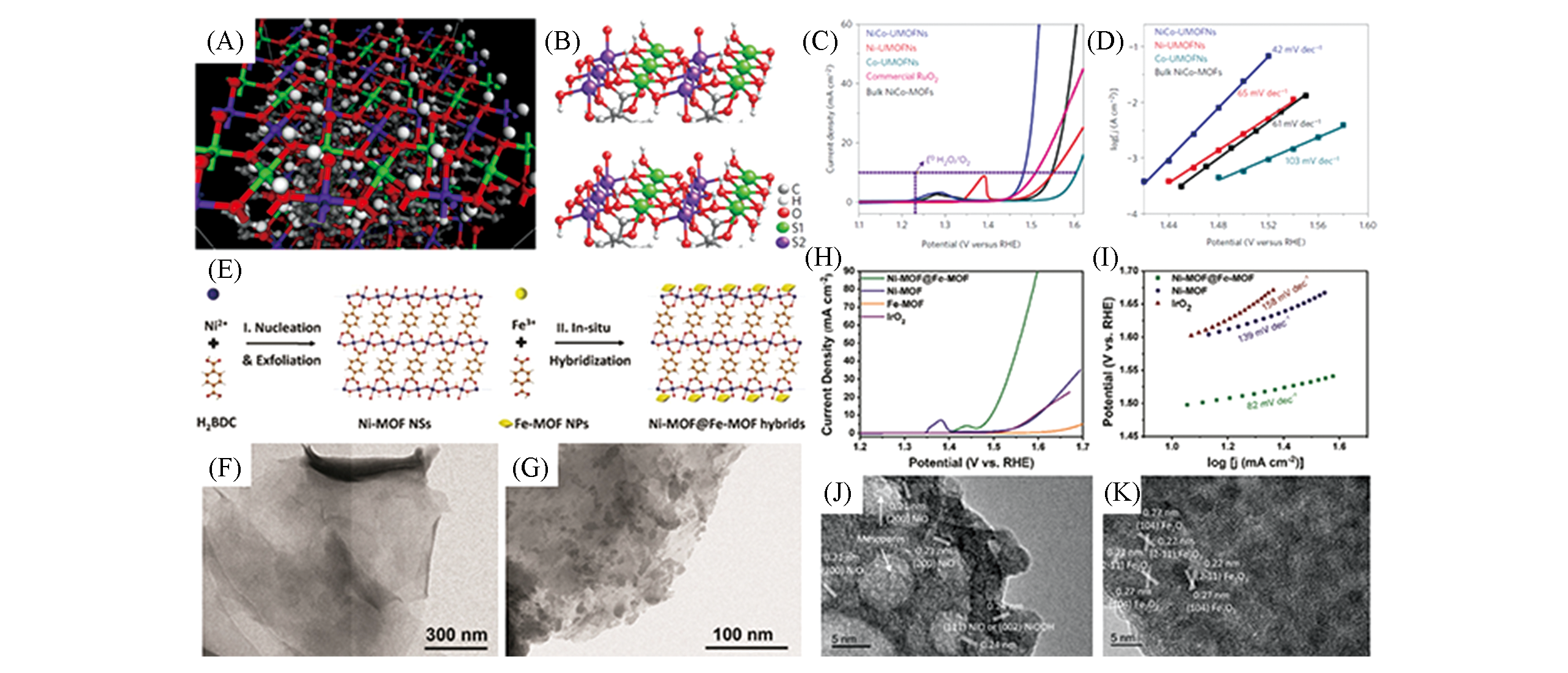
Fig.16 Applications of 2D MOFs in OER electrocatalysis(A) Structural simulation of a UMOFNs surface with rich coordinatively unsaturated sites; (B) atomic models of fully unsaturated(upper) and partially unsaturated(lower) sites on surfaces of UMOFNs; (C) OER polarization curves and (D) Tafel plots of UMOFNs[83]; Copyright 2016, Springer Nature; (E) schematic illustration of the synthetic route of Ni-MOF@Fe-MOF hybrids; TEM images of Ni-MOF(F) and Ni-MOF@Fe-MOF(G); OER polarization curves(H) and Tafel plots(I) of Ni-MOF@Fe-MOF, Ni-MOF, Fe-MOF and IrO2; HRTEM images of Ni-MOF@Fe-MOF(J) and Fe-MOF(K) after CV cycles[133]; Copyright 2018, Wiley-VCH.

Fig.17 Applications of 2D MOFs in ORR electrocatalysis(A) Structural model of Ni3(HITP)2; (B) ORR polarization curves of Ni3(HITP)2[135]; Copyright 2016, Springer Nature; structu-ral model(C) and TEM image(D) of PcCu-O8-Co; (E) differential charge density image of PcCu-O8-Co; (F) proposed ORR mechanism on the Co site of PcCu-O8-Co; (G) ORR polarization curves of PcCu-O8-Co/CNT and other samples;(H) ORR polarization curves of PcCu-O8-Co/CNT before and after 5000 CV cycles[63]; Copyright 2019, Wiley-VCH.
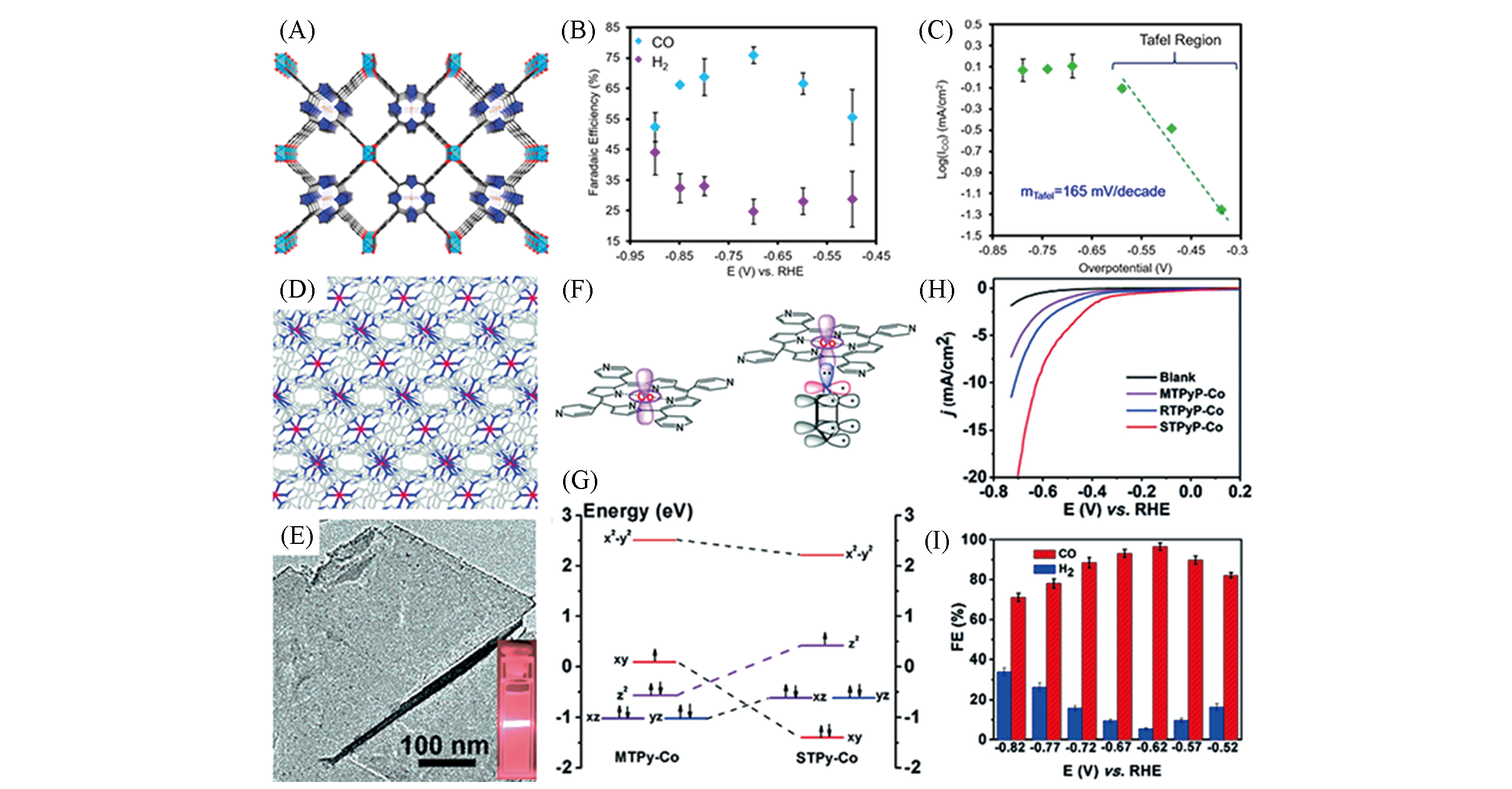
Fig.18 Applications of 2D MOFs in CO2RR electrocatalysis(A) Structural illustration of Al2(OH)2TCPP-Co; selectivity test(B) and Tafel plot(C) of Al2(OH)2TCPP-Co[89]; Copyright 2015, American Chemical Society; (D) simulated crystal structure of STPyP-Co; (E) TEM image of STPyP-Co; (F) interaction between pyridine and central Co; (G) orbital splitting of Co centers in MTPyP-Co and STPyP-Co; (H) polarization curves of STPyP-Co and other samples; (I) Faradaic efficiency for STPyP-Co at different applied potential[141]; Copyright 2019, Wiley-VCH.
| 1 | Chu S., Majumdar A., Nature, 2012, 488(7411), 294—303 |
| 2 | Turner J. A., Science, 2004, 305(5686), 972—974 |
| 3 | Jiao Y., Zheng Y., Jaroniec M., Qiao S. Z., Chem. Soc. Rev., 2015, 44(8), 2060—2086 |
| 4 | Ross M. B., De Luna P., Li Y., Dinh C. T., Kim D., Yang P., Sargent E. H., Nat. Catal., 2019, 2, 648—658 |
| 5 | Luo M., Zhao Z., Zhang Y., Sun Y., Xing Y., Lv F., Yang Y., Zhang X., Hwang S., Qin Y., Ma J. Y., Lin F., Su D., Lu G., Guo S., Nature, 2019, 574(7776), 81—85 |
| 6 | Zhao Z., Chen C., Liu Z., Huang J., Wu M., Liu H., Li Y., Huang Y., Adv. Mater., 2019, 31(31), 1808115 |
| 7 | Tackett B. M., Gomez E., Chen J. G., Nat. Catal., 2019, 2(5), 381—386 |
| 8 | Kibsgaard J., Chorkendorff I., Nat. Energy, 2019, 4(6), 430—433 |
| 9 | King L. A., Hubert M. A., Capuano C., Manco J., Danilovic N., Valle E., Hellstern T. R., Ayers K., Jaramillo T. F., Nat. Nanotechnol., 2019, 14(11), 1071—1074 |
| 10 | Farha O. K., Hupp J. T., Acc. Chem. Res., 2010, 43(8), 1166—1175 |
| 11 | Lee J., Farha O. K., Roberts J., Scheidt K. A., Nguyen S. T., Hupp J. T., Chem. Soc. Rev., 2009, 38(5), 1450—1459 |
| 12 | Downes C. A., Marinescu S. C., ChemSusChem, 2017, 10(22), 4374—4392 |
| 13 | Seh Z. W., Kibsgaard J., Dickens C. F., Chorkendorff I., Norskov J. K., Jaramillo T. F., Science, 2017, 355(6321), eaad4998 |
| 14 | Corma A., García H., Llabrés i Xamena F. X., Chem. Rev., 2010, 110(8), 4606—4655 |
| 15 | Hu A., Pang Q., Tang C., Bao J., Liu H., Ba K., Xie S., Chen J., Chen J., Yue Y., Tang Y., Li Q., Sun Z., J. Am. Chem. Soc., 2019, 141(28), 11322—11327 |
| 16 | Cao S., Gody G., Zhao W., Perrier S., Peng X., Ducati C., Zhao D., Cheetham A. K., Chem. Sci., 2013, 4(9), 3573—3577 |
| 17 | Cai G., Jiang H. L., Angew. Chem. Int. Ed., 2017, 56(2), 563—567 |
| 18 | Sheberla D., Bachman J. C., Elias J. S., Sun C. J., Shao⁃Horn Y., Dinca M., Nat. Mater., 2017, 16(2), 220—224 |
| 19 | Seh Z. W., Fredrickson K. D., Anasori B., Kibsgaard J., Strickler A. L., Lukatskaya M. R., Gogotsi Y., Jaramillo T. F., Vojvodic A., ACS Energy Lett., 2016, 1(3), 589—594 |
| 20 | Li Y., Wang H., Xie L., Liang Y., Hong G., Dai H., J. Am. Chem. Soc., 2011, 133(19), 7296—7299 |
| 21 | Zhao Y., Yang N., Yao H., Liu D., Song L., Zhu J., Li S., Gu L., Lin K., Wang D., J. Am. Chem. Soc., 2019, 141(18), 7240—7244 |
| 22 | Yang J., Zeng Z., Kang J., Betzler S., Czarnik C., Zhang X., Ophus C., Yu C., Bustillo K., Pan M., Qiu J., Wang L. W., Zheng H., Nat. Mater., 2019, 18(9), 970—976 |
| 23 | Yang S., Dong J., Yao Z., Shen C., Shi X., Tian Y., Lin S., Zhang X., Sci. Rep., 2014, 4, 4501 |
| 24 | Liang Y., Li Y., Wang H., Zhou J., Wang J., Regier T., Dai H., Nat. Mater., 2011, 10(10), 780—786 |
| 25 | Guo L., Yang Z., Marcus K., Li Z., Luo B., Zhou L., Wang X., Du Y., Yang Y., Energy Environ. Sci., 2018, 11(1), 106—114 |
| 26 | Zhao J., Shao M., Yan D., Zhang S., Lu Z., Li Z., Cao X., Wang B., Wei M., Evans D. G., Duan X., J. Mater. Chem. A, 2013, 1(19), 5840—5846 |
| 27 | Xiao X., Wang H., Bao W., Urbankowski P., Yang L., Yang Y., Maleski K., Cui L., Billinge S. J. L., Wang G., Gogotsi Y., Adv. Mater., 2019, 31, 1902393 |
| 28 | Gan Q., He H., Zhao K., He Z., Liu S., J. Colloid. Interface. Sci., 2018, 530, 127—136 |
| 29 | Wang Y., Liu Y., Wang H., Liu W., Li Y., Zhang J., Hou H., Yang J., ACS Appl. Energy Mater., 2019, 2(3), 2063—2071 |
| 30 | Zhao M., Lu Q., Ma Q., Zhang H., Small Methods, 2017, 1(1/2), 1600030 |
| 31 | Zhao M., Wang Y., Ma Q., Huang Y., Zhang X., Ping J., Zhang Z., Lu Q., Yu Y., Xu H., Zhao Y., Zhang H., Adv. Mater., 2015, 27(45), 7372—7378 |
| 32 | Zhao M., Huang Y., Peng Y., Huang Z., Ma Q., Zhang H., Chem. Soc. Rev., 2018, 47(16), 6267—6295 |
| 33 | Jiang Q., Zhou C., Meng H., Han Y., Shi X., Zhan C., Zhang R., J. Mater. Chem. A, 2020, 8, 15271—15301 |
| 34 | Jia W., Wu B., Sun S., Wu P., Nano Res., 2020, 13(11), 2973—2978 |
| 35 | Meng Z., Mirica K. A., Nano Res., 2020, DOI: 10.1007/s12274-020-2874-x |
| 36 | Zhao K., Zhu W., Liu S., Wei X., Ye G., Su Y., He Z., Nanoscale Adv., 2020, 2(2), 536—562 |
| 37 | Chandrasekhar P., Mukhopadhyay A., Savitha G., Moorthy J. N., J. Mater. Chem. A, 2017, 5(11), 5402—5412 |
| 38 | Hermosa C., Horrocks B. R., Martinez J. I., Liscio F., Gomez⁃Herrero J., Zamora F., Chem. Sci., 2015, 6(4), 2553—2558 |
| 39 | Ding Y., Chen Y. P., Zhang X., Chen L., Dong Z., Jiang H. L., Xu H., Zhou H. C., J. Am. Chem. Soc., 2017, 139(27), 9136—9139 |
| 40 | Abherve A., Manas⁃Valero S., Clemente⁃Leon M., Coronado E., Chem. Sci., 2015, 6(8), 4665—4673 |
| 41 | Zhang H., ACS Nano, 2015, 9(10), 9451—9469 |
| 42 | Coleman J. N., Acc. Chem. Res., 2013, 46(1), 14—22 |
| 43 | Nicolosi V., Chhowalla M., Kanatzidis M. G., Strano M. S., Coleman J. N., Science, 2013, 340(6139), 1226419 |
| 44 | Gedanken A., Ultrason. Sonochem., 2004, 11(2), 47—55 |
| 45 | Peng Y., Li Y., Ban Y., Jin H., Jiao W., Liu X., Yang W., Science, 2014, 346(6215), 1356—1359 |
| 46 | Quah H. S., Ng L. T., Donnadieu B., Tan G. K., Vittal J. J., Inorg. Chem., 2016, 55(21), 10851—10854 |
| 47 | Matte H. S., Gomathi A., Manna A. K., Late D. J., Datta R., Pati S. K., Rao C. N., Angew. Chem. Int. Ed., 2010, 49(24), 4059—4062 |
| 48 | Lukatskaya M. R., Mashtalir O., Ren C. E., Dall’Agnese Y., Rozier P., Taberna P. L., Naguib M., Simon P., Barsoum M. W., Gogotsi Y., Science, 2013, 341(6153), 1502—1505 |
| 49 | Wang H. S., Li J., Li J. Y., Wang K., Ding Y., Xia X. H., NPG Asia Mater., 2017, 9(3), e354 |
| 50 | Huang J., Li Y., Huang R. K., He C. T., Gong L., Hu Q., Wang L., Xu Y. T., Tian X. Y., Liu S. Y., Ye Z. M., Wang F., Zhou D. D., Zhang W. X., Zhang J. P., Angew. Chem. Int. Ed., 2018, 57(17), 4632—4636 |
| 51 | Novoselov K. S., Geim A. K., Morozov S. V., Jiang D., Zhang Y., Dubonos S. V., Grigorieva I. V., Firsov A. A., Science, 2004, 306(5696), 666—669 |
| 52 | Novoselov K. S., Jiang D., Schedin F., Booth T. J., Khotkevich V. V., Morozov S. V., Geim A. K., PNAS, 2005, 102(30), 10451—10453 |
| 53 | Wang X., Chi C., Zhang K., Qian Y., Gupta K. M., Kang Z., Jiang J., Zhao D., Nat. Commun., 2017, 8, 14460 |
| 54 | Zheng S., Li B., Tang Y., Li Q., Xue H., Pang H., Nanoscale, 2018, 10(27), 13270—13276 |
| 55 | Han B., Ou X., Deng Z., Song Y., Tian C., Deng H., Xu Y. J., Lin Z., Angew. Chem. Int. Ed., 2018, 57(51), 16811—16815 |
| 56 | Jian M., Liu H., Williams T., Ma J., Wang H., Zhang X., Chem. Commun., 2017, 53(98), 13161—13164 |
| 57 | Yang L., Zhu G., Wen H., Guan X., Sun X., Feng H., Tian W., Zheng D., Cheng X., Yao Y., J. Mater. Chem. A, 2019, 7(15), 8771—8776 |
| 58 | Pham M. H., Vuong G. T., Fontaine F. G., Do T. O., Cryst. Growth Des., 2012, 12(6), 3091—3095 |
| 59 | Sakata Y., Furukawa S., Kondo M., Hirai K., Horike N., Takashima Y., Uehara H., Louvain N., Meilikhov M., Tsuruoka T., Isoda S., Kosaka W., Sakata O., Kitagawa S., Science, 2013, 339(6116), 193—196 |
| 60 | Stock N., Biswas S., Chem. Rev., 2012, 112(2), 933—969 |
| 61 | Li F. L., Wang P., Huang X., Young D. J., Wang H. F., Braunstein P., Lang J. P., Angew. Chem. Int. Ed., 2019, 58(21), 7051—7056 |
| 62 | Li G., Zhang X., Zhang H., Liao C., Jiang G., Appl. Catal. B: Environ., 2019, 249, 147—154 |
| 63 | Zhong H., Ly K. H., Wang M., Krupskaya Y., Han X., Zhang J., Zhang J., Kataev V., Buchner B., Weidinger I. M., Kaskel S., Liu P., Chen M., Dong R., Feng X., Angew. Chem. Int. Ed., 2019, 58(31), 10677—10682 |
| 64 | Cao F., Zhao M., Yu Y., Chen B., Huang Y., Yang J., Cao X., Lu Q., Zhang X., Zhang Z., Tan C., Zhang H., J. Am. Chem. Soc., 2016, 138(22), 6924—6927 |
| 65 | Huang Y., Zhao M., Han S., Lai Z., Yang J., Tan C., Ma Q., Lu Q., Chen J., Zhang X., Zhang Z., Li B., Chen B., Zong Y., Zhang H., Adv. Mater., 2017, 29(32), 1700102 |
| 66 | Lu Q., Zhao M., Chen J., Chen B., Tan C., Zhang X., Huang Y., Yang J., Cao F., Yu Y., Ping J., Zhang Z., Wu X. J., Zhang H., Small, 2016, 12(34), 4669—4674 |
| 67 | Zhang X., Chang L., Yang Z., Shi Y., Long C., Han J., Zhang B., Qiu X., Li G., Tang Z., Nano Res., 2018, 12(2), 437—440 |
| 68 | Junggeburth S. C., Diehl L., Werner S., Duppel V., Sigle W., Lotsch B. V., J. Am. Chem. Soc., 2013, 135(16), 6157—6164 |
| 69 | Sun L., Wang C., Wang X., Wang L., Small, 2018, 14(27), 1800090 |
| 70 | Wang Y., Zhao M., Ping J., Chen B., Cao X., Huang Y., Tan C., Ma Q., Wu S., Yu Y., Lu Q., Chen J., Zhao W., Ying Y., Zhang H., Adv. Mater., 2016, 28(21), 4149—4155 |
| 71 | Cao L., Lin Z., Peng F., Wang W., Huang R., Wang C., Yan J., Liang J., Zhang Z., Zhang T., Long L., Sun J., Lin W., Angew. Chem. Int. Ed., 2016, 55(16), 4962—4966 |
| 72 | Zhao K., Liu S., Ye G., Gan Q., Zhou Z., He Z., J. Mater. Chem. A, 2018, 6(5), 2166—2175 |
| 73 | Zhao K., Liu S., Ye G., Wei X., Su Y., Zhu W., Zhou Z., He Z., ChemSusChem, 2020, 13(6), 1556—1567 |
| 74 | Cho W., Lee H. J., Oh M., J. Am. Chem. Soc., 2008, 130(50), 16943—16946 |
| 75 | He S., Chen Y., Zhang Z., Ni B., He W., Wang X., Chem. Sci., 2016, 7(12), 7101—7105 |
| 76 | Jiang Y., Ryu G. H., Joo S. H., Chen X., Lee S. H., Chen X., Huang M., Wu X., Luo D., Huang Y., Lee J. H., Wang B., Zhang X., Kwak S. K., Lee Z., Ruoff R. S., ACS Appl. Mater. Interfaces, 2017, 9(33), 28107—28116 |
| 77 | Bauer T., Zheng Z., Renn A., Enning R., Stemmer A., Sakamoto J., Schluter A. D., Angew. Chem. Int. Ed., 2011, 50(34), 7879—7884 |
| 78 | Dong R., Zheng Z., Tranca D. C., Zhang J., Chandrasekhar N., Liu S., Zhuang X., Seifert G., Feng X., Chem. Eur. J., 2017, 23(10), 2255—2260 |
| 79 | Kambe T., Sakamoto R., Hoshiko K., Takada K., Miyachi M., Ryu J. H., Sasaki S., Kim J., Nakazato K., Takata M., Nishihara H., J. Am. Chem. Soc., 2013, 135(7), 2462—2465 |
| 80 | Makiura R., Konovalov O., Sci. Rep., 2013, 3, 2506 |
| 81 | Makiura R., Motoyama S., Umemura Y., Yamanaka H., Sakata O., Kitagawa H., Nat. Mater., 2010, 9(7), 565—571 |
| 82 | Xu H., Zeiger B. W., Suslick K. S., Chem. Soc. Rev., 2013, 42(7), 2555—2567 |
| 83 | Zhao S., Wang Y., Dong J., He C. T., Yin H., An P., Zhao K., Zhang X., Gao C., Zhang L., Lv J., Wang J., Zhang J., Khattak A. M., Khan N. A., Wei Z., Zhang J., Liu S., Zhao H., Tang Z., Nat. Energy, 2016, 1, 16184 |
| 84 | Hai G., Jia X., Zhang K., Liu X., Wu Z., Wang G., Nano Energy, 2018, 44, 345—352 |
| 85 | Zhu D., Guo C., Liu J., Wang L., Du Y., Qiao S. Z., Chem. Commun., 2017, 53(79), 10906—10909 |
| 86 | Sun F., Wang G., Ding Y., Wang C., Yuan B., Lin Y., Adv. Energy Mater., 2018, 8(21), 1800584 |
| 87 | Chen J., Zhuang P., Ge Y., Chu H., Yao L., Cao Y., Wang Z., Chee M. O. L., Dong P., Shen J., Ye M., Ajayan P. M., Adv. Funct. Mater., 2019, 29(37), 1903875 |
| 88 | Zhuang L., Ge L., Liu H., Jiang Z., Jia Y., Li Z., Yang D., Hocking R. K., Li M., Zhang L., Wang X., Yao X., Zhu Z., Angew. Chem. Int. Ed., 2019, 131(38), 13699—13706 |
| 89 | Kornienko N., Zhao Y., Kley C. S., Zhu C., Kim D., Lin S., Chang C. J., Yaghi O. M., Yang P., J. Am. Chem. Soc., 2015, 137(44), 14129—14135 |
| 90 | Huang X., Zhang Y., Shen H., Li W., Shen T., Ali Z., Tang T., Guo S., Sun Q., Hou Y., ACS Energy Lett., 2018, 3(12), 2914—2920 |
| 91 | Wang T., Kou Z., Mu S., Liu J., He D., Amiinu I. S., Meng W., Zhou K., Luo Z., Chaemchuen S., Verpoort F., Adv. Funct. Mater., 2018, 28(5), 1705048 |
| 92 | Ding B., Wang J., Chang Z., Xu G., Hao X., Shen L., Dou H., Zhang X., ChemElectroChem, 2016, 3(4), 668—674 |
| 93 | Jiang M., Li J., Cai X., Zhao Y., Pan L., Cao Q., Wang D., Du Y., Nanoscale, 2018, 10(42), 19774—19780 |
| 94 | Gao J., Wang Y., Wu H., Liu X., Wang L., Yu Q., Li A., Wang H., Song C., Gao Z., Peng M., Zhang M., Ma N., Wang J., Zhou W., Wang G., Yin Z., Ma D., Angew. Chem. Int. Ed., 2019, 58(42), 15089—15097 |
| 95 | Xia W., Tang J., Li J., Zhang S., Wu K. C. W., He J., Yamauchi Y., Angew. Chem. Int. Ed., 2019, 58(38), 13354—13359 |
| 96 | Zhu X., Jiang Q., Wang T., Zhang Q., Jia X., Zhang R., ChemSusChem, 2019, 12(18), 4323—4331 |
| 97 | Chen Z., Qing H., Zhou K., Sun D., Wu R., Prog. Mater. Sci., 2020, 108, 100618 |
| 98 | Zhang Y., Zhang H. B., Wu X., Deng Z., Zhou E., Yu Z. Z., ACS Appl. Nano Mater., 2019, 2(4), 2325—2335 |
| 99 | Li J., Xia W., Tang J., Tan H., Wang J., Kaneti Y. V., Bando Y., Wang T., He J., Yamauchi Y., Nanoscale Horiz., 2019, 4(4), 1006—1013 |
| 100 | Wei G., Zhou Z., Zhao X., Zhang W., An C., ACS Appl. Mater. Interfaces, 2018, 10(28), 23721—23730 |
| 101 | Zhou J., Dou Y., Zhou A., Shu L., Chen Y., Li J. R., ACS Energy Lett., 2018, 3(7), 1655—1661 |
| 102 | Guan C., Zhao W., Hu Y., Lai Z., Li X., Sun S., Zhang H., Cheetham A. K., Wang J., Nanoscale Horiz., 2017, 2(2), 99—105 |
| 103 | Nai J., Lu Y., Yu L., Wang X., Lou X. W., Adv. Mater., 2017, 29(41), 1703870 |
| 104 | Dong Y., Shi W., Lu P., Qin J., Zheng S., Zhang B., Bao X., Wu Z. S., J. Mater. Chem. A, 2018, 6(29), 14324—14329 |
| 105 | Liu S., Li D., Zhang G., Sun D., Zhou J., Song H., ACS Appl. Mater. Interfaces, 2018, 10(40), 34193—34201 |
| 106 | Dhakshinamoorthy A., Asiri A. M., Garcia H., Adv. Mater., 2019, 31(41), 1900617 |
| 107 | Masoomi M. Y., Morsali A., Dhakshinamoorthy A., Garcia H., Angew. Chem. Int. Ed., 2019, 58(43), 15188—15205 |
| 108 | Zhang W., Liu Y., Lu G., Wang Y., Li S., Cui C., Wu J., Xu Z., Tian D., Huang W., DuCheneu J. S., Wei W. D., Chen H., Yang Y., Huo F., Adv. Mater., 2015, 27(18), 2923—2929 |
| 109 | Feng D., Gu Z. Y., Li J. R., Jiang H. L., Wei Z., Zhou H. C., Angew. Chem. Int. Ed., 2012, 51(41), 10307—10310 |
| 110 | Kim Y., Yang T., Yun G., Ghasemian M. B., Koo J., Lee E., Cho S. J., Kim K., Angew. Chem. Int. Ed., 2015, 54(45), 13273—13278 |
| 111 | Shen K., Zhang L., Chen X., Liu L., Zhang D., Han Y., Chen J., Long J., Luque R., Li Y., Chen B., Science, 2018, 359(6372), 206—210 |
| 112 | Vermoortele F., Bueken B., Le Bars G., Van de Voorde B., Vandichel M., Houthoofd K., Vimont A., Daturi M., Waroquier M., van Speybroeck V., Kirschhock C., de Vos D. E., J. Am. Chem. Soc., 2013, 135(31), 11465—11468 |
| 113 | Qian Q., Li Y., Liu Y., Yu L., Zhang G., Adv. Mater., 2019, 31(23), 1901139 |
| 114 | Xu J., Zhu X., Jia X., ACS Sustainable Chem. Eng., 2019, 7(19), 16629—16639 |
| 115 | Shimoni R., He W., Liberman I., Hod I., J. Phys. Chem. C, 2019, 123(9), 5531—5539 |
| 116 | Wang Z., Xu W., Chen X., Peng Y., Song Y., Lv C., Liu H., Sun J., Yuan D., Li X., Guo X., Yang D., Zhang L., Adv. Funct. Mater., 2019, 29(33), 1902875 |
| 117 | Xue Z., Liu K., Liu Q., Li Y., Li M., Su C. Y., Ogiwara N., Kobayashi H., Kitagawa H., Liu M., Li G., Nat. Commun., 2019, 10(1), 5048 |
| 118 | Chen Z., Wu R., Liu Y., Ha Y., Guo Y., Sun D., Liu M., Fang F., Adv. Mater., 2018, 30(30), 1802011 |
| 119 | Dou J. H., Sun L., Ge Y., Li W., Hendon C. H., Li J., Gul S., Yano J., Stach E. A., Dincă M., J. Am. Chem. Soc., 2017, 139(39), 13608—13611 |
| 120 | Rui K., Zhao G., Lao M., Cui P., Zheng X., Zheng X., Zhu J., Huang W., Dou S. X., Sun W., Nano Lett., 2019, 19(12), 8447—8453 |
| 121 | Guo C., Jiao Y., Zheng Y., Luo J., Davey K., Qiao S. Z., Chem., 2019, 5(9), 2429—2441 |
| 122 | Guntern Y. T., Pankhurst J. R., Vávra J., Mensi M., Mantella V., Schouwink P., Buonsanti R., Angew. Chem. Int. Ed., 2019, 58(36), 12632—12639 |
| 123 | Sengupta A., Datta S., Su C., Herng T. S., Ding J., Vittal J. J., Loh K. P., ACS Appl. Mater. Interfaces, 2016, 8(25), 16154—16159 |
| 124 | Cui Y., Yan J., Chen Z., Zhang J., Zou Y., Sun Y., Xu W., Zhu D., Adv. Sci., 2019, 6(9), 1802235 |
| 125 | Chalk S. G., Miller J. F., J. Power Sources, 2006, 159(1), 73—80 |
| 126 | Dong R., Pfeffermann M., Liang H., Zheng Z., Zhu X., Zhang J., Feng X., Angew. Chem. Int. Ed., 2015, 54(41), 12058—12063 |
| 127 | Xia Z., Fang J., Zhang X., Fan L., Barlow A. J., Lin T., Wang S., Wallace G. G., Sun G., Wang X., Appl. Catal. B: Environ., 2019, 245, 389—398 |
| 128 | Hu A., Pang Q., Tang C., Bao J., Liu H., Ba K., Xie S., Chen J., Chen J., Yue Y., Tang Y., Li Q., Sun Z., J. Am. Chem. Soc., 2019, 141(28), 11322—11327 |
| 129 | Wang H. F., Xu Q., Matter, 2019, 1(3), 565—595 |
| 130 | Chen Z., Xu H., Ha Y., Li X., Liu M., Wu R., Appl. Catal. B: Environ., 2019, 250, 213—223 |
| 131 | Zhu B., Xia D., Zou R., Coord. Chem. Rev., 2018, 376, 430—448 |
| 132 | Subbaraman R., Tripkovic D., Chang K. C., Strmcnik D., Paulikas A. P., Hirunsit P., Chan M., Greeley J., Stamenkovic V., Markovic N. M., Nat. Mater., 2012, 11(6), 550—557 |
| 133 | Rui K., Zhao G., Chen Y., Lin Y., Zhou Q., Chen J., Zhu J., Sun W., Huang W., Dou S. X., Adv. Funct. Mater., 2018, 28(26), 1801554 |
| 134 | Huang X., Shen T., Zhang T., Qiu H., Gu X., Ali Z., Hou Y., Adv. Energy Mater., 2020, 10(11), 1900375 |
| 135 | Miner E. M., Fukushima T., Sheberla D., Sun L., Surendranath Y., Dincǎ M., Nat. Commun., 2016, 7, 10942 |
| 136 | Meng J., Lei H., Li X., Qi J., Zhang W., Cao R., ACS Catal., 2019, 9(5), 4551—4560 |
| 137 | Ye G., He Q., Liu S., Zhao K., Su Y., Zhu W., Huang R., He Z., J. Mater. Chem. A, 2019, 7(27), 16508—16515 |
| 138 | Cui L., Cui L., Li Z., Zhang J., Wang H., Lu S., Xiang Y., J. Mater. Chem. A, 2019, 7(28), 16690—16695 |
| 139 | Yang Q., Yang C. C., Lin C. H., Jiang H. L., Angew. Chem. Int. Ed., 2019, 58(11), 3511—3515 |
| 140 | Sun Z., Ma T., Tao H., Fan Q., Han B., Chem., 2017, 3(4), 560—587 |
| 141 | Han J., An P., Liu S., Zhang X., Wang D., Yuan Y., Guo J., Qiu X., Hou K., Shi L., Zhang Y., Zhao S., Long C., Tang Z., Angew. Chem. Int. Ed., 2019, 58, 2—8 |
| 142 | Howarth A. J., Liu Y., Li P., Li Z., Wang T. C., Hupp J. T., Farha O. K., Nat. Rev. Mater., 2016, 1(3), 15018 |
| 143 | Shang L., Bian T., Zhang B., Zhang D., Wu L. Z., Tung C. H., Yin Y., Zhang T., Angew. Chem. Int. Ed., 2014, 53(1), 250—254 |
| 144 | Zou Z., Wang T., Zhao X., Jiang W. J., Pan H., Gao D., Xu C., ACS Catal., 2019, 9(8), 7356—7364 |
| 145 | Zhang P., Yang X., Gao W., Hou X., Mi J., Liu L., Huang J., Dong M., Stampfl C., Catal. Sci. Technol., 2018, 8(14), 3666—3674 |
| [1] | 林高鑫, 王家成. 单原子掺杂二硫化钼析氢催化的进展和展望[J]. 高等学校化学学报, 2022, 43(9): 20220321. |
| [2] | 汪思聪, 庞贝贝, 刘潇康, 丁韬, 姚涛. XAFS技术在单原子电催化中的应用[J]. 高等学校化学学报, 2022, 43(9): 20220487. |
| [3] | 秦永吉, 罗俊. 单原子催化剂在CO2转化中的应用[J]. 高等学校化学学报, 2022, 43(9): 20220300. |
| [4] | 姚青, 俞志勇, 黄小青. 单原子催化剂的合成及其能源电催化应用的研究进展[J]. 高等学校化学学报, 2022, 43(9): 20220323. |
| [5] | 范建玲, 唐灏, 秦凤娟, 许文静, 谷鸿飞, 裴加景, 陈文星. 氮掺杂超薄碳纳米片复合铂钌单原子合金催化剂的电化学析氢性能[J]. 高等学校化学学报, 2022, 43(9): 20220366. |
| [6] | 韩付超, 李福进, 陈良, 贺磊义, 姜玉南, 徐守冬, 张鼎, 其鲁. CoSe2/C复合电催化材料修饰隔膜对高载量锂硫电池性能的影响[J]. 高等学校化学学报, 2022, 43(8): 20220163. |
| [7] | 王茹涵, 贾顺涵, 吴丽敏, 孙晓甫, 韩布兴. CO2参与电化学构筑C—N键制备重要化学品[J]. 高等学校化学学报, 2022, 43(7): 20220395. |
| [8] | 彭奎霖, 李桂林, 江重阳, 曾少娟, 张香平. 电解液调控CO2电催化还原性能微观机制的研究进展[J]. 高等学校化学学报, 2022, 43(7): 20220238. |
| [9] | 王丽君, 李欣, 洪崧, 詹新雨, 王迪, 郝磊端, 孙振宇. 调节氧化镉-炭黑界面高效电催化CO2还原生成CO[J]. 高等学校化学学报, 2022, 43(7): 20220317. |
| [10] | 赵润瑶, 纪桂鹏, 刘志敏. 吡咯氮配位单原子铜催化剂的电催化二氧化碳还原性能[J]. 高等学校化学学报, 2022, 43(7): 20220272. |
| [11] | 姜宏斌, 代文臣, 张娆, 徐晓晨, 陈捷, 杨光, 杨凤林. Co3O4/UiO-66@α-Al2O3陶瓷膜对VOCs废气的分离催化性能[J]. 高等学校化学学报, 2022, 43(6): 20220025. |
| [12] | 龚妍熹, 王建兵, 柴歩瑜, 韩元春, 马云飞, 贾超敏. 钾掺杂g-C3N4薄膜光阳极的制备及光电催化氧化降解水中双氯芬酸钠性能[J]. 高等学校化学学报, 2022, 43(6): 20220005. |
| [13] | 杨丽君, 于洋, 张蕾. 双功能2D/3D杂化结构Co2P-CeO x 异质结一体化电极的构筑及电催化尿素氧化辅助制氢性能[J]. 高等学校化学学报, 2022, 43(6): 20220082. |
| [14] | 夏天, 万家炜, 于然波. 异原子配位结构碳基单原子电催化剂结构与性能相关性的研究进展[J]. 高等学校化学学报, 2022, 43(5): 20220162. |
| [15] | 黄汉浩, 卢湫阳, 孙明子, 黄勃龙. 石墨炔原子催化剂的崭新道路:基于自验证机器学习方法的筛选策略[J]. 高等学校化学学报, 2022, 43(5): 20220042. |
| 阅读次数 | ||||||
|
全文 |
|
|||||
|
摘要 |
|
|||||